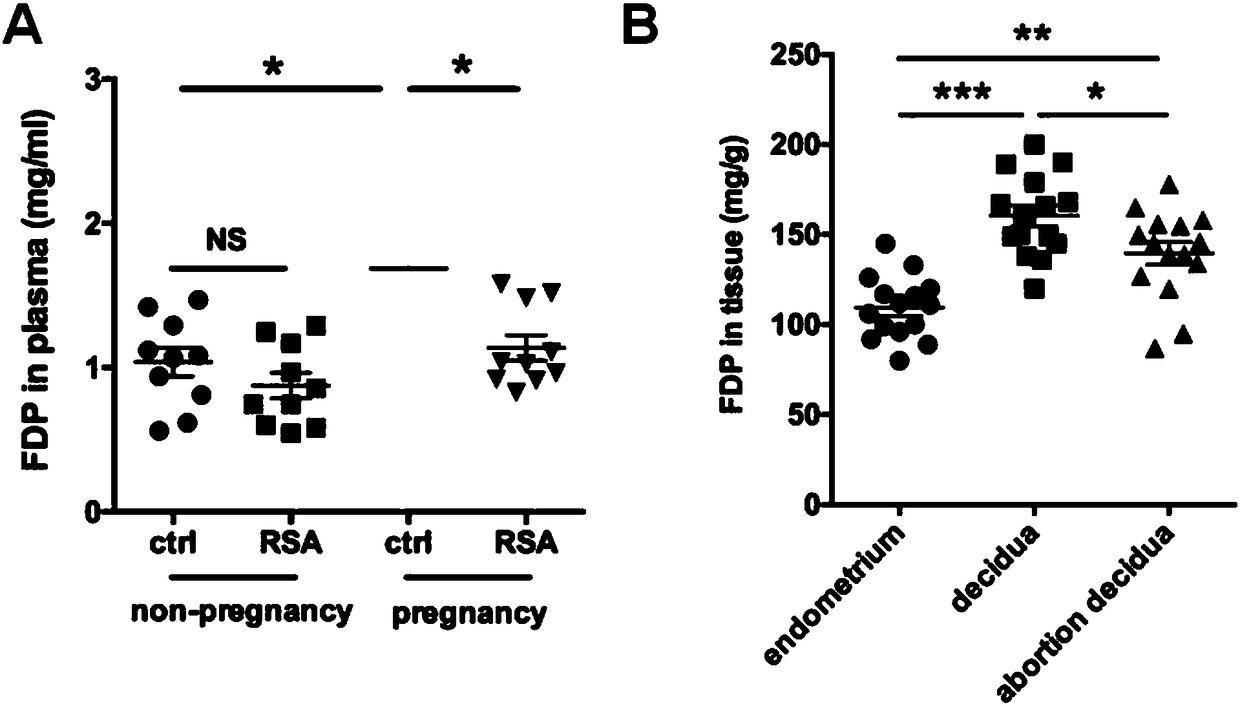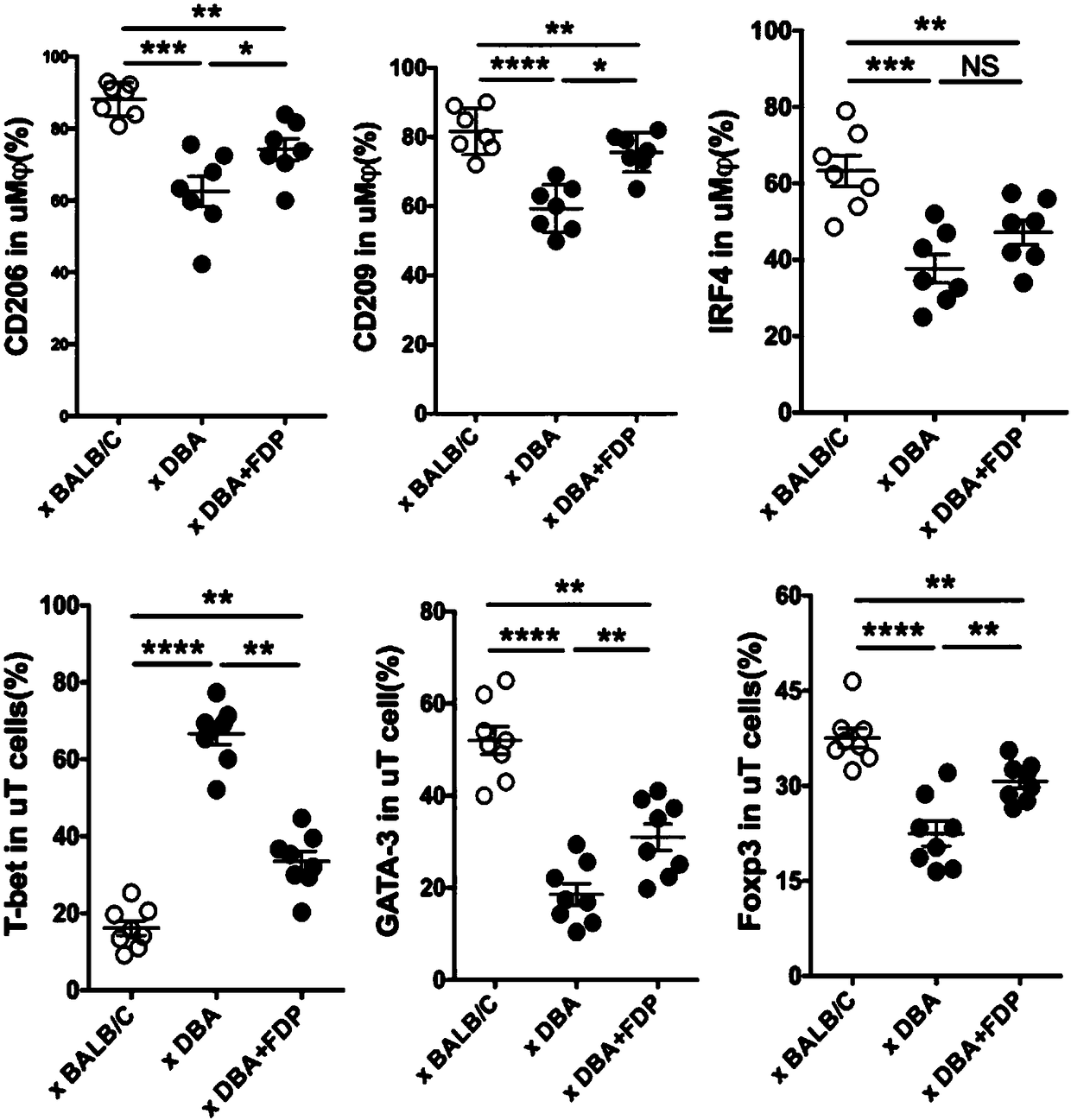Application of fructose 1,6-diphosphate (FDP) in preparation of fetus protection medicine for spontaneous abortion
A fructose diphosphate, spontaneous abortion technology, applied in the field of biomedicine, can solve the problem of unclear molecular mechanism of RSA
- Summary
- Abstract
- Description
- Claims
- Application Information
AI Technical Summary
Problems solved by technology
Method used
Image
Examples
Embodiment 1
[0054] Embodiment 1 analyzes the concentration of 1,6-fructose diphosphate in the peripheral blood, endometrium or decidua of non-pregnant, early pregnant and RSA patients
[0055] 1) The concentration of fructose 1,6-bisphosphate in peripheral blood and decidua decreased in RSA patients
[0056] First, using the 1,6-diphosphate fructose detection kit (Qingdao Jieshikang Co., Ltd.), it was found that compared with non-pregnant women, the concentration of peripheral blood 1,6-diphosphate fructose increased in early pregnancy women, and was higher than that of RSA patients ( Such as figure 1 Shown in A); Compared with the endometrial tissue of non-pregnant women, the concentration of 1,6-diphosphate fructose in the decidua tissue of early pregnant women increased, and was higher than that of RSA patients (such as figure 1 shown in B).
[0057] 2) The concentration of fructose-1,6-bisphosphate in the uterus of spontaneous abortion model mice decreased
[0058] After constructi...
Embodiment 2
[0059] Example 2 The in vivo experiment confirmed that the supplementation of fructose 1,6-diphosphate significantly improved the pattern of uterine immune tolerance in spontaneously aborted pregnant mice
[0060] Using flow cytometry (all flow cytometry antibodies come from BioLegend), it was found that, compared with control pregnant mice, the CD45 + F4 / 80 + Decreased expression of M2 phenotype molecules (CD206, CD209 and IRF4) in macrophages, CD45 + CD4 + GATA-3 + Helper T(Th)2 and CD45 + CD4 + Foxp3 + The proportion of regulatory T cells decreased; in contrast CD45 + CD4 + T-bet + Elevated Th1 cells (eg image 3 shown). The spontaneous abortion pregnant mice group was intraperitoneally injected with 1,6-diphosphate fructose (the method is the same as above) or control saline, and the uteri of pregnant mice were collected on the 14th day of pregnancy. The ratio of M2 macrophages, Th2 and Treg cells in the uterus of spontaneous abortion pregnant mice was high, and...
Embodiment 3
[0061] Example 3 The in vivo experiment confirmed that the supplementation of fructose 1,6-diphosphate significantly improved the degree of uterine decidualization in spontaneously aborted pregnant mice
[0062] Real-time RCR (Takara was purchased from Takara Company) was used to analyze and find that, compared with control pregnant mice, the decidualization-related genes Lif, Prlr, IL11, Ihh, Igfbp1, dPRP, Cebpb, Hoxa10, The transcript levels of Wnt4 and Bmp2 (primers were synthesized by Shanghai Sangon) were significantly reduced (eg Figure 4 shown). The spontaneous abortion pregnant mice group was intraperitoneally injected with 1,6-diphosphate fructose (the same method as above) or control saline, and the uteri of pregnant mice were collected on the 14th day of pregnancy. The transcription of the above decidualization-related genes in the uterus of spontaneously aborted pregnant mice (such as Figure 4 shown). It suggested that the supplementation of fructose 1,6-dipho...
PUM
 Login to View More
Login to View More Abstract
Description
Claims
Application Information
 Login to View More
Login to View More - R&D
- Intellectual Property
- Life Sciences
- Materials
- Tech Scout
- Unparalleled Data Quality
- Higher Quality Content
- 60% Fewer Hallucinations
Browse by: Latest US Patents, China's latest patents, Technical Efficacy Thesaurus, Application Domain, Technology Topic, Popular Technical Reports.
© 2025 PatSnap. All rights reserved.Legal|Privacy policy|Modern Slavery Act Transparency Statement|Sitemap|About US| Contact US: help@patsnap.com



